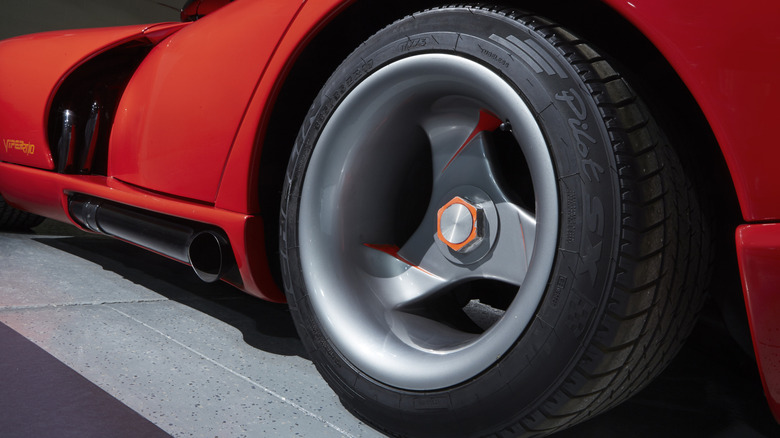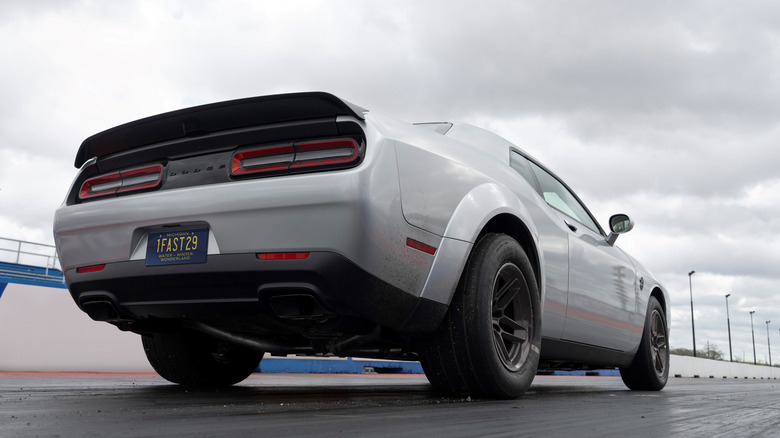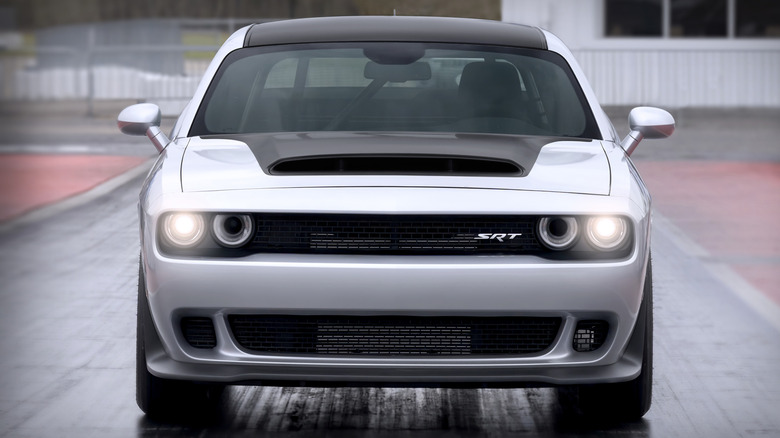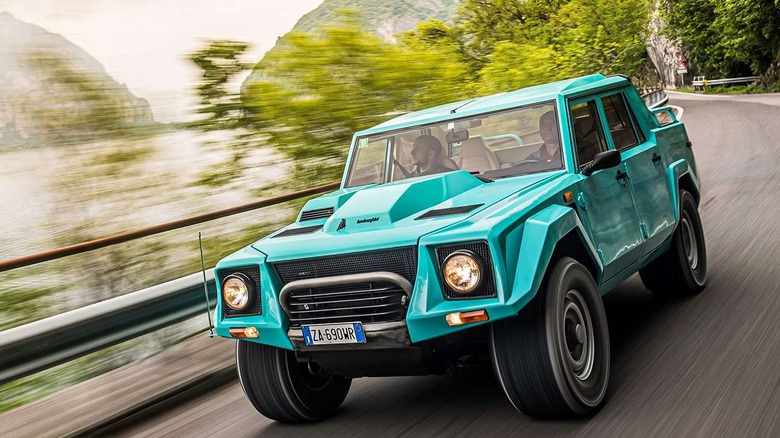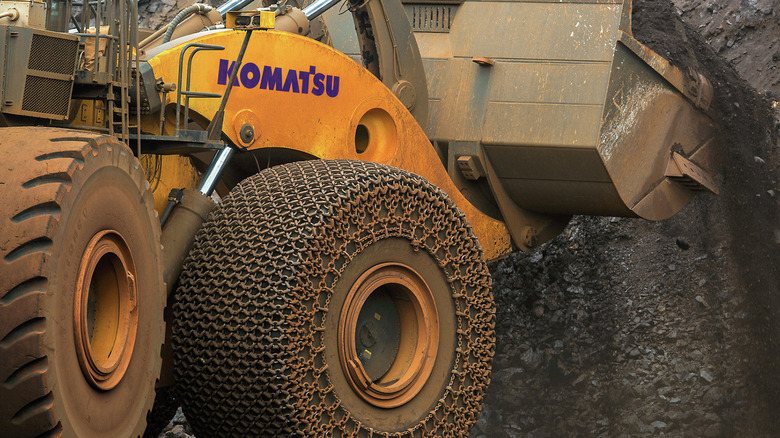Which Cars Come With The Widest Tires From The Factory? (And Why Are They So Wide?)
If you ever look at a high-power sports car or an exotic supercar from the back, you might notice its extremely wide tires. Some of these vehicles utilize tires that are twice as wide as many subcompacts, but which ones come with the absolute widest set? And why bother with such wide tires, anyway?
In this article, we'll be looking exclusively at production cars, so vehicles like race cars and motorcycles are off-limits. However, we will have to stretch the definition of "factory-production car," since virtually all of these vehicles are limited-production, high-end exotics. Most people will go their whole live without ever seeing one of them in the wild. If you're more interested in learning about the widest tires ever used on a racing vehicle, then look no further than Top Fuel dragsters. These cars actually use their tires like a transmission, with the tire changing its shape through centrifugal force when the driver hits the throttle.
Tires themselves have drastically evolved since the dawn of the automobile, but their purpose remains the same: They are the interface between the car and the road. As such, their primary function is to grip the surface of the road. The more rubber is in contact with the road, the highest the grip. And while there are many great tire brands around the world, not all of them make them quite as wide as what we're looking for.
Why a tire's width matters
Some cars come with famously wide tires, such as the Lamborghini Countach and its 335mm-wide rear Pirellis that had to be custom-made, since no brand built them that wide at the time. Likewise, every Dodge Viper generation featured wide rear tires, beginning with 335s in its initial production year. To put it into perspective, let's look at the most popular sedan in America: the Toyota Camry. This typical passenger car uses 205mm tires front and rear in the FWD hybrid trim. A classic Volkswagen ranks among the narrowest tires still in production, with these cars coming with 165mm tires from the factory. In other words, a Lamborghini Countach features a tire that's wider than two Volkswagen tires put together.
Why these tires are so wide? The answer rests in their grip level. These cars require such wide tires simply because they would be nigh-uncontrollable without them. Take the Viper RT/10, for example, a car which notoriously required tremendous respect to drive quickly. It was a spartan muscle car with virtually no protections against poor throttle management. Instead, it relied entirely on its massive rear tires to maintain some semblance of control. Other vehicles, like large trucks and off-road cars, require super-wide tires to optimize ground pressure instead.
Widest rear tires: Bugatti Veyron - 365mm
Believe it or not, many cars feature tire widths of 335 or 345mm rears — a few even require 355s — but the Veyron was the first passenger car in history to sport 365mm rear tires. Despite this beast of a car featuring a sophisticated AWD system to help manage its 1,000-plus horsepower, it was still the fastest car in the world at the time of its introduction. No standard tire short of those used in land speed racing could handle 250-plus miles per hour. The burden of producing such a tire that was both safe to use at these speeds and comfortable enough to manage daily driving went to French tire manufacturer Michelin, which produced the 14.4 inch-wide rear tires. That's why, much like the Veyron itself, the tires are equally sophisticated and ludicrously expensive: each set costs a cool $42,000.
The Veyron's tires are technological marvels, but even so, they reportedly still only last for 15 minutes at full-speed. Nevertheless, they actually function remarkably competently as street tires, thanks to the Michelin PAX System. This mechanism automatically monitors tire pressure, more or less like a modern tire pressure monitoring system (TPMS), and the tires are so well-constructed that they can run flat for 125 miles, eliminating the need for a spare tire and saving crucial room and weight in favor of jamming even more power into the car. This conjures up the rather humorous thought of what a space-saving tire would look like on the back of a $1.6 million-dollar Veyron, of all things.
Widest front tires: 2018 Dodge Challenger SRT Demon - 315mm
The Dodge Challenger doesn't have the widest front tires of any production vehicle, just the widest in a car. We'll get to which one holds that title later. When it comes to high-performance coupes, it doesn't get much more ubiquitous than the Dodge Challenger, at least in the United States. Since the car's launch in 2008 and up to its discontinuation, the Challenger remained an ever-popular choice for modern muscle car enthusiasts, thanks in part to its incredible performance threshold for the price. One of the most exclusive trim levels available right off the factory was the SRT Demon package, the top-of-the-line for 2018. This included an 808-horsepower 6.2L supercharged Hemi which launched this monstrosity to a 10.8-second quarter-mile pass at 130 miles per hour. That's proper super-stock pass times on a car with a warranty sticker.
Much like the Veyron, the tires on the Challenger SRT Demon are unique to the car, except in this case they're street-legal and designed for drag racing. Those are the Nitto NT05Rs on the original Demon models, replaced with 245mm front tires by Mickey Thompson on the subsequent Demon 170. No matter which one you get, the Dodge Challenger SRT Demon is one of the most specialized, modern factory dragsters that money can buy. The last edition of the Demon 170 is one of the muscle cars with the highest horsepower ever made, with a staggering 1,025 horsepower.
Widest combined footprint of any car: Lamborghini LM002 - 345mm front and rear
Nicknamed the "Rambo Lambo," this vehicle doesn't look like a car as much as an extraordinarily eccentric military-style truck. This SUV by Lamborghini, the LM002, is quite literally a Countach engine fitted with a 4WD military-style body, and by all accounts, it's every bit as preposterous as it sounds. This includes its infamous, massive tires.
The Dodge Challenger SRT Demon is widely-regarded as having the largest front tires of any production car, at 315mm. There are larger tires out there, specifically those made for trucks — take the Hummer H1, for instance, with 317.5mm fronts. Few vehicles exceed that, with the most distinctive being the massive 345mm Pirelli Scorpions fitted to the LM002. Pirelli manufactured these especially for the LM002, thanks to its long-term partnership with Lamborghini. All that width is required for two reasons: the first is that the LM002 shares its 444-horsepower V12 engine with the Countach, meaning you need plenty of grip to reign it in, while the second is related to ground pressure.
Ground pressure is the amount of downward force the car exerts on the ground beneath it; a larger contact patch means the weight is dissipated, rather than being focused on a small area. This means that, despite the LM002's immense proportions, it won't sink as quickly into soft terrain, in addition to providing excellent off-road traction. On the downside, tires this massive require muscle strands like bridge cables to turn the wheel, even with power steering. There are some tires out there which exceed even these proportions, though these tread into specialized trucks and agricultural equipment territory, like the Mercedes-Benz Unimog's 425mm front / 475mm rear.
The widest tires in the world: Firestone 70/70x57 SRG - 1884mm
It's tough to put a tire this big into perspective, so let's look at some core statistics instead. The Firestone 70/70x57 SRG is the largest tire in the world, as well as the widest, beating even monoliths like the widest agricultural tire, the 1,400mm-wide Titan LSW1400. By contrast, the Firestone boasts a staggering total diameter of 70 to 74.2 inches (or 1,702 to 1,884mm) per tire.
This tire is designed for extra-heavy duty loads carried by some of the world's largest vehicles, namely quarry and mine dozers and loaders. It's currently utilized by the Komatsu L-2350 loader, the largest loader in the world, and by the Caterpillar 994H. Curiously, the Komatsu features built-in electric motors housed in the hubs as generators that help rotate and slow down its massive wheels, similar to how hybrids utilize regenerative braking. Each tire weighs between 22,000 and ~32,800 pounds, and can cost up to $120,000, making it one of the world's most expensive tires. It's also massive, being 13 feet tall and 5.8 feet wide.
These tires have to use every inch of their width because they operate almost exclusively on the rough terrain of job sites like quarries. That's why they're often fitted with chains, which help with traction on loose surfaces. Tread patterns are also important and can vary, with some being designed for specific work environments. Tires like the Firestone these represent true marvels of engineering, and are surely a sight to behold, but sadly, they will not fit on a Dodge Challenger Demon.
